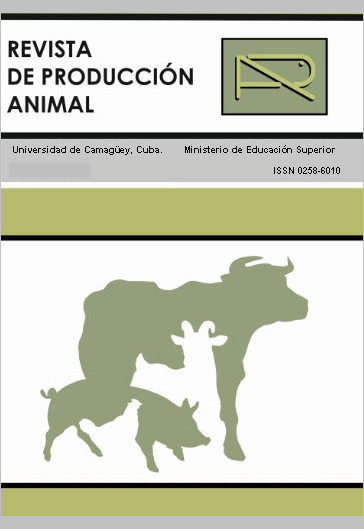Seasonal Behavior of Fasciola hepatica in Sacrificed Bovines at Chacuba Slaughterhouse, Camagüey, Cuba.
Resumen
To determine the existence of seasonal patterns for Fasciola hepatica infestation in bovines slaughtered in the province of Camaguey, Cuba, information gathered from 13 059 bovines sacrificed at the Chacuba slaughterhouse (Terso Livestock Basic Marketing Company, Maraguan Livestock Company), between 2008 and 2014, was used. The study included 2 387 animals affected by F. hepatica, according to the anatomical and pathological diagnostic made at the slaughterhouse. Prevalence calculations were based on the sacrificed and affected animals (18.27%) for the entire period. The seasonal decomposition process was based on additive model. It revealed the existence of sea-sonal behavior for the animals affected by Fasciola hepatica and its prevalence. The seasonal patterns had peaks inFebruary, October and December for the two variables studied. Evaluation of intermediate hosts dynamics and larval F. hepatica stages were associated to the seasonal patterns observed.
Descargas
Citas
ARTEAGA, A. (2014). Redes neuronales en la predicción de pevalencia de Fasciola hepatica en el matadero Chacuba de Camagüey, Cuba. Tesis de Maestría en Diagnóstico Veterinario.
BENNEMA, S.; SCHOLTE, R.; MOLENTO, M.; MEDEIROS, C. y CARVALHO, O. (2014). Fasciola hepatica in Bovines in Brazil: Data Availability and Spatial Distribution. Rev. Inst. Med. Trop., 56 (1), 35-41.
BOSCO, A.; RINALDI, L. y MUSELLA, V. (2015). Outbreak of Acute Fasciolosis in Sheep Farms in a Mediterranean Area Arising As a Possible Consequence of Climate Change. Geospatial Health, 9 (2), 319-324.
CAMINADE, C. y VAN DIJK, J. (2015). Modelling Recent and Future Climatic Suitability for Fasciolosis in Europe. Geospatial Health, 2 (9), 301-308.
ESCALONA, C. (2012). Fasciolosis aguda. Rev. Chilena Infectol., 29 (5), 543-546. Retrieved on January 12, 2016, fromhttp://dx.doi.org/10.4067S0716-10182012000600013.
FIGUEROA, J.; BERTOT, J. y VÁZQUEZ, R. (2010). Detección de hembras en estro en una empresa pecuaria. Revista de Producción Animal, 22 (2), 61-67.
FOX, N.; WHITE, P.; MCCLEAN, C.; MARION, G.; EVANS, A. y HUTCHINGS, M. (2011). Predicting Impacts of Climate Change on Fasciola hepatica Risk. PLoS ONE 6 (1), e16126.
GARCÍA, R.; BETANCOURT, J.; GUEVARA, R.; FAJARDO, H. y ÉVORA, J. C. (2005, noviembre). Época de parto, un asunto de interés para ga-nadería de leche y carne en el trópico. III Congreso Internacional Sobre Mejoramiento Animal, 7 al 11, Ciudad de La Habana, Cuba.
GIMÉNEZ, T.; NÚÑEZ, A.; CHAMORRO, N. y ALARCÓN,
G. (2014). Estudio de la infección natural por Fasciola hepática en Lymnaea spp. Compend. cienc. vet., 4 (02), 14-18.
LEÓN, M.; SILVEIRA, E.; PÉREZ, J. y OLAZÁBAL, E.
(2013). Evaluación de los factores que inciden en la mortalidad por fasciolosis en la provincia de Villa Clara, Cuba. REDVET, 7 (2), 1-13. Extraído el 12 de enero de 2016, de http://www.veterinaria.org/revistas/redvet/n020206
/020606.pdf.
RAMÍREZ, J. A.; BERTOT, J. A.; LOYOLA, C.; VÁZQUEZ, R., GARAY, M., AVILÉS, R. (2010). Análisis de la estacionalidad de los nacimientos y las categorías reproductivas en empresas pecuarias lecheras de La Habana. Revista de Producción Animal, 22 (2), 68-74.
ROBERTSON, LUCY y SELSTAD UTAAKER, K. (2014). Climate Change nd Foodborne Transmission of Parasites: A Consideration of Possible Interactions and Impacts for Selected Parasites. Food Research International, 68, 16-23. Retrieved on January 12, 2016, from http://www.sciencedirect.com/science/article/pii/S0963996914004566.
SELEMETAS, N. (2015). Spatial Analysis and Risk Mapping of Fasciola hepatica Infection in Dairy Herds in Ireland. Geospatial Health, 9 (2), 281-291.
TICONA, S.; CHÁVEZ, V.; CASAS, V. y CHAVERA, C. (2010). Prevalencia de Fasciola hepatica en bovinos y ovinos de Vilcashuamán. Rev. Investig. vet. Perú, 21 (2), 3-15.
VAN DIJK, J.; SMITH, D.; WILLIAMS, D.; BAYLIS, M.; CAMINADE, C.; MCAROLINE, F. y ROSE, W. (2016). Climate Change and Fasciola hepatica Abundance. Will Models Developed in Europe be Applicable to Cuba? Fluke Models. Clase magistral. Facultad de Ciencias Agropecuarias, Universidad de Camagüey. Cuba.
VÁZQUEZ, A.; SÁNCHEZ, J.; ALBA, A. y POINTIER, J.
(2015). Natural Prevalence in Cuban Populations of the lymnaeid snail Galba cubensis Infected with the Liver Fluke Fasciola hepatica: Small Values do Matter. Parasitology Res, 114 (11), 4205-4210. Ex-traído el 12 de enero de 2016, de
http://link.springer.com/article/10.100/s00436-015-4653-2.
VÁZQUEZ, A.; GUTIÉRREZ, A. y SÁNCHEZ, J. (2010). Estudios de diversidad en comunidades de moluscos fluviales de importancia médica. Revista Cuba-na de Medicina Tropical. 60 (2):159-161. Extraído el 12 de enero de 2016, de http://scielo.sld.cu/scielo.php?script=sci_arttext&pid=S0375-07602008000200009.
Los autores de los artículos publicados en RPA retienen los derechos de autor de su trabajo, de marca y patente, y también sobre cualquier proceso o procedimiento descrito en el artículo, así como a compartir, copiar, distribuir, ejecutar y comunicar públicamente el artículo publicado en la RPA o cualquier parte de aquel siempre que indiquen la fuente de publicación (autores del trabajo, revista, volumen, número y fecha), pero están de acuerdo en que la revista publique los trabajos bajo una licencia Creative Commons.
![]() Licencia Attribution-NonCommercial 4.0 International (CC BY-NC 4.0)
Licencia Attribution-NonCommercial 4.0 International (CC BY-NC 4.0)






































